中考英语常用句型及解释
初中英语中考常考固定短语句型汇总(共80个)
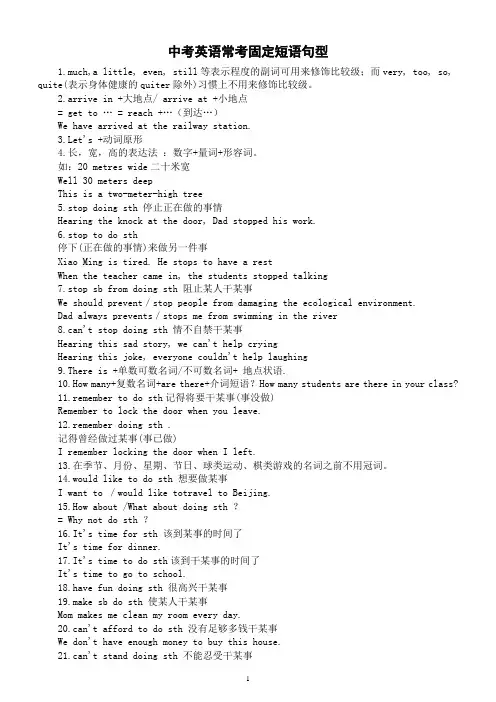
中考英语常考固定短语句型1.much,a little, even, still等表示程度的副词可用来修饰比较级;而very, too, so, quite(表示身体健康的quiter除外)习惯上不用来修饰比较级。
2.arrive in +大地点/ arrive at +小地点= get to … = reach +…(到达…)We have arrived at the railway station.3.Let's +动词原形4.长,宽,高的表达法:数字+量词+形容词。
如:20 metres wide二十米宽Well 30 meters deepThis is a two-meter-high tree5.stop doing sth 停止正在做的事情Hearing the knock at the door, Dad stopped his work.6.stop to do sth停下(正在做的事情)来做另一件事Xiao Ming is tired. He stops to have a restWhen the teacher came in, the students stopped talking7.stop sb from doing sth 阻止某人干某事We should prevent/stop people from damaging the ecological environment.Dad always prevents/stops me from swimming in the river8.can't stop doing sth 情不自禁干某事Hearing this sad story, we can't help cryingHearing this joke, everyone couldn't help laughing9.There is +单数可数名词/不可数名词+ 地点状语.10.How many+复数名词+are there+介词短语?How many students are there in your class?11.remember to do sth记得将要干某事(事没做)Remember to lock the door when you leave.12.remember doing sth .记得曾经做过某事(事已做)I remember locking the door when I left.13.在季节、月份、星期、节日、球类运动、棋类游戏的名词之前不用冠词。
中考常考的英语五种句式及真题解析
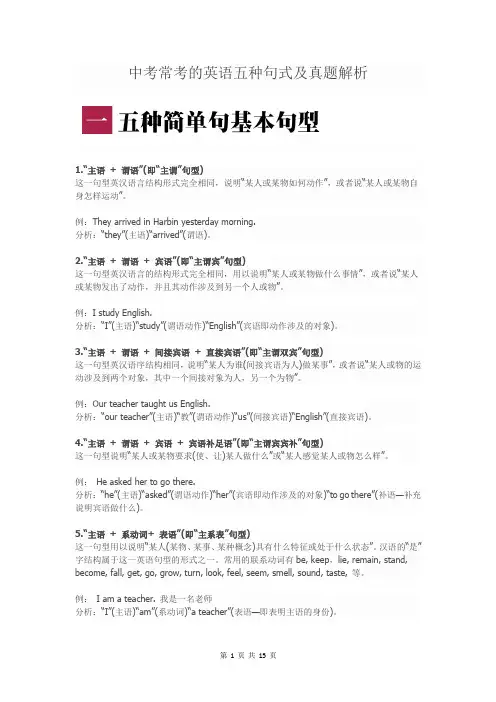
中考常考的英语五种句式及真题解析1.“主语+ 谓语”(即“主谓”句型)这一句型英汉语言结构形式完全相同,说明“某人或某物如何动作”,或者说“某人或某物自身怎样运动”。
例:They arrived in Harbin yesterday morning.分析:“they”(主语)“arrived”(谓语)。
2.“主语+ 谓语+ 宾语”(即“主谓宾”句型)这一句型英汉语言的结构形式完全相同,用以说明“某人或某物做什么事情”,或者说“某人或某物发出了动作,并且其动作涉及到另一个人或物”。
例:I study English.分析:“I”(主语)“study”(谓语动作)“English”(宾语即动作涉及的对象)。
3.“主语+ 谓语+ 间接宾语+ 直接宾语”(即“主谓双宾”句型)这一句型英汉语序结构相同,说明“某人为谁(间接宾语为人)做某事”,或者说“某人或物的运动涉及到两个对象,其中一个间接对象为人,另一个为物”。
例:Our teacher taught us English.分析:“our teacher”(主语)“教”(谓语动作)“us”(间接宾语)“English”(直接宾语)。
4.“主语+ 谓语+ 宾语+ 宾语补足语”(即“主谓宾宾补”句型)这一句型说明“某人或某物要求(使、让)某人做什么”或“某人感觉某人或物怎么样”。
例:He asked her to go there.分析:“he”(主语)“asked”(谓语动作)“her”(宾语即动作涉及的对象)“to go there”(补语—补充说明宾语做什么)。
5.“主语+ 系动词+ 表语”(即“主系表”句型)这一句型用以说明“某人(某物、某事、某种概念)具有什么特征或处于什么状态”。
汉语的“是”字结构属于这一英语句型的形式之一。
常用的联系动词有be, keep,lie, remain, stand, become, fall, get, go, grow, turn, look, feel, seem, smell, sound, taste, 等。
中考英语300经典句涵盖高频词语、短语、句型、考点
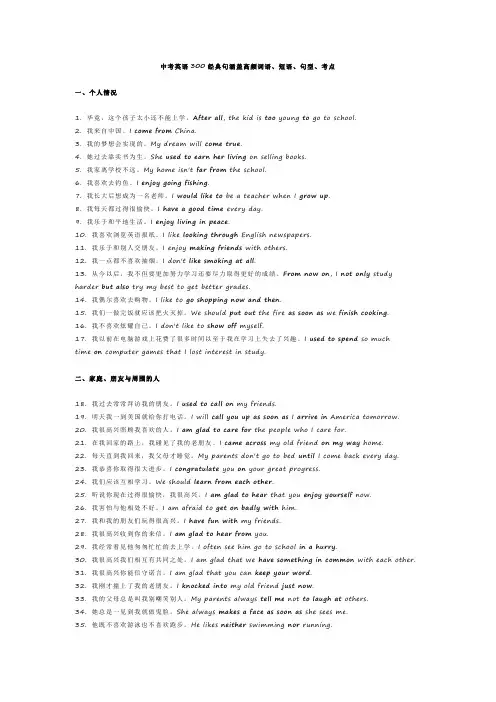
中考英语300经典句涵盖高频词语、短语、句型、考点一、个人情况1. 毕竟,这个孩子太小还不能上学。
After all, the kid is too young to go to school.2. 我来自中国。
I come from China.3. 我的梦想会实现的。
My dream will come true.4. 她过去靠卖书为生。
She used to earn her living on selling books.5. 我家离学校不远。
My home isn't far from the school.6. 我喜欢去钓鱼。
I enjoy going fishing.7. 我长大后想成为一名老师。
I would like to be a teacher when I grow up.8. 我每天都过得很愉快。
I have a good time every day.9. 我乐于和平地生活。
I enjoy living in peace.10. 我喜欢浏览英语报纸。
I like looking through English newspapers.11. 我乐于和别人交朋友。
I enjoy making friends with others.12. 我一点都不喜欢抽烟。
I don't like smoking at all.13. 从今以后,我不但要更加努力学习还要尽力取得更好的成绩。
From now on, I not only study harder but also try my best to get better grades.14. 我偶尔喜欢去购物。
I like to go shopping now and then.15. 我们一做完饭就应该把火灭掉。
We should put out the fire as soon as we finish cooking.16. 我不喜欢炫耀自己。
【精品】中考英语作文好词好句积累

中考英语作文好词好句积累------------------------------------------作者------------------------------------------日期中考英语作文好词好句积累(描写人物篇)一、外貌体形(一)常用句型:①主语+ be + adj/n.. 例如:She is of medium height. 她中等身材。
②主语+ be + a + adj. + man / woman / girl / boy. 例如:He is a grey-haired thin old man. 他是一位白发苍苍的瘦老头。
③某人 + has + adj. + 身体部位。
例如:She has a round face and wide eyes. 她长着圆圆的脸,大大的眼睛。
(二)常用词语:①表“长相”常用词语:good-looking 长得好看的,ugly-looking 长得难看的, ordinary-looking长相一般的, funny-looking 长相滑稽的,white-haired白头发的,beautiful 漂亮的,pretty 漂亮的,handsome (男子)英俊的,漂亮的,broad shoulder宽肩膀,wide eyes大眼睛,wide mouth大嘴巴。
②表“体形”常用词语:tall高的, short矮的,be of medium height中等身材,be short in stature身材矮小,fat胖的, thin瘦的, slim苗条的,full-bodied魁梧的。
常用描写人物的形容词:determined (有毅力的)competent 有能力的warm - hearted (热心肠的easy - going (温和宽容的)energetic(精力充沛)generous(慷慨的)intelligent(精明的)ambitious(雄心的)forgetful(健忘的)honest (诚实的)humorous (幽默的)independent (独立的)diligent (勤奋的)cautious (谨慎的)talkative (多话的)healthy (健康的)attractive (有吸引力的)patient (耐心的)strict (严格的)modest(谦虚的)considerate(考虑周到的) outstanding (杰出的)optimistic(乐观的)enthusiastic(热情的)二、身高体重(一)表“身高”的句型:①主语 + be + 数词 + 单位 + tall.②主语 + be + 数词 + 单位 + in height. 例如:He is 1.72 metres tall/in height. 他身高一米七二。
(全)2021中考英语:高频考点+句型详细解析-人教版
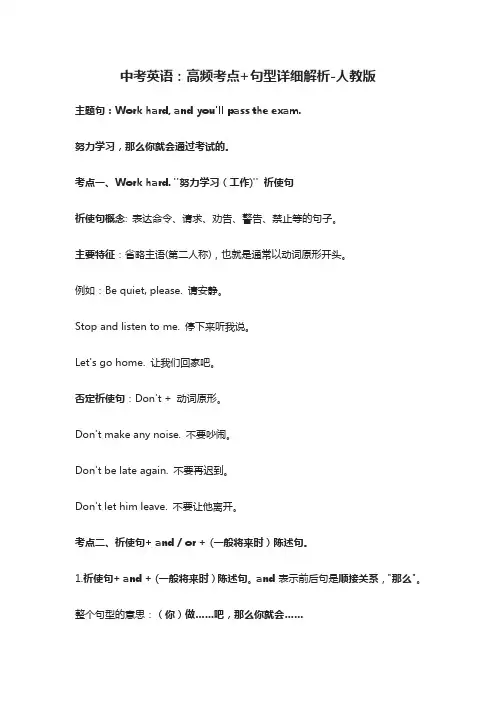
中考英语:高频考点+句型详细解析-人教版主题句:Work hard, and you'll pass the exam.努力学习,那么你就会通过考试的。
考点一、Work hard. "努力学习(工作)" 祈使句祈使句概念: 表达命令、请求、劝告、警告、禁止等的句子。
主要特征:省略主语(第二人称),也就是通常以动词原形开头。
例如:Be quiet, please. 请安静。
Stop and listen to me. 停下来听我说。
Let's go home. 让我们回家吧。
否定祈使句:Don't + 动词原形。
Don't make any noise. 不要吵闹。
Don't be late again. 不要再迟到。
Don't let him leave. 不要让他离开。
考点二、祈使句+ and / or + (一般将来时)陈述句。
1.祈使句+ and + (一般将来时)陈述句。
and表示前后句是顺接关系,"那么"。
整个句型的意思:(你)做……吧,那么你就会……Keep doing sports, and you'll get healthier. 坚持做运动,那么你就会身体好起来。
Get up early, and you'll catch the early bus. 早点起床,那么你就会赶上早班车。
2. 祈使句+ or + (一般将来时)陈述句。
or表示前后句是转折关系,"否则的话"整个句型的意思是:(你)做……吧,否则的话你就会……Work hard, or you won't pass the exam. 努力学习吧,否则你不会通过考试的。
Be careful, or you will make more mistakes. 仔细些,否则你会犯更多错误的。
中考英语必考的60个句型
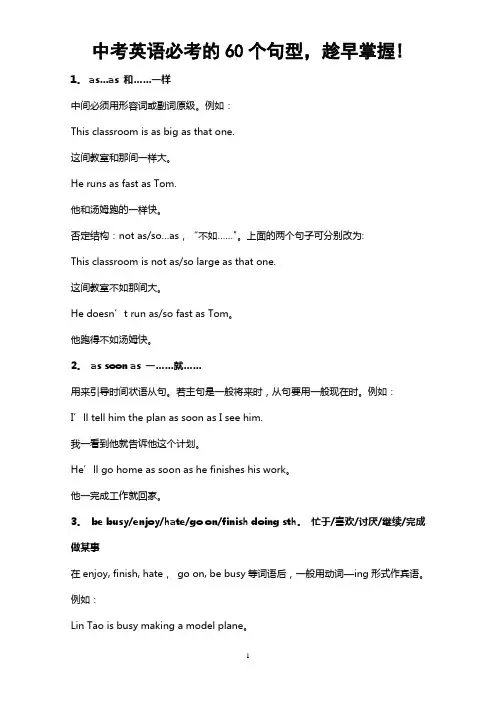
中考英语必考的60个句型,趁早掌握!1。
as…as 和……一样中间必须用形容词或副词原级。
例如:This classroom is as big as that one.这间教室和那间一样大。
He runs as fast as Tom.他和汤姆跑的一样快。
否定结构:not as/so…as,“不如……"。
上面的两个句子可分别改为:This classroom is not as/so large as that one.这间教室不如那间大。
He doesn’t run as/so fast as Tom。
他跑得不如汤姆快。
2。
as soon as 一……就……用来引导时间状语从句。
若主句是一般将来时,从句要用一般现在时。
例如:I’ll tell him the plan as soon as I see him.我一看到他就告诉他这个计划。
He’ll go home as soon as he finishes his work。
他一完成工作就回家。
3。
be busy/enjoy/hate/go on/finish doing sth。
忙于/喜欢/讨厌/继续/完成做某事在enjoy, finish, hate,go on, be busy等词语后,一般用动词—ing形式作宾语。
例如:Lin Tao is busy making a model plane。
林涛正忙着做飞机模型。
My mother enjoys taking a walk after supper。
我妈妈喜欢晚饭后散步。
I hate watching Channel Five。
我讨厌看五频道。
When someone asked him to have a rest,he just went on working。
当有人让他休息一会儿时,他仍继续工作。
I have finished writing the story。
初中英语中考常考句型及例句(共九大类60个)
中考英语常考句型及例句一、请求类1.Could you please…(你能不能请...)Could you please send me the latest report?(你能不能请发给我最新的报告?)2.I would be grateful if you could…(如果你能...我将不胜感激)I would be grateful if you could give me some advice on this matter.(如果你能就这件事给我一些建议, 我将不胜感激。
)3.Would you mind…(你介意...)Would you mind sending me the document again?(你介意再把文件发给我一遍吗?)4.Can/Could you do me a favor?(你能否帮我一个忙?)Could you do me a favor and take care of my pet while I am on vacation?(你能否帮我一个忙,照顾一下我的宠物,我要去度假。
)5.I am writing to reque st…(我写信是为了请求...)I am writing to request a refund for the defective product I received.(我写信是为了请求退款,因为我收到的产品有缺陷。
)二、建议类6.I suggest that…(我建议...)I suggest that we should hold a meeting to discuss the issue.(我建议我们应该开一个会议来讨论这个问题。
)7.It might be a good i dea to…(做...可能是个不错的主意)It might be a good idea to hire an intern to help with the workload.(请一个实习生来帮忙可能是个不错的主意。
(全)2021中考英语高频考点+句型详细解析-人教
中考英语高频考点+句型详细解析-人教主题句:I was so tired that I went to sleep early.我太累了,所以早早就睡觉了。
考点一、so…that…结构(1) so + 形容词/ 副词+ that 从句,表示"如此……以至于……", that 后接结果状语从句。
It's so hot that I can't sleep. 天气热得我不能入睡。
He got up so late that he missed the early bus. 他起床太晚了以至于错过了早班车。
(2) so + 形容词+ a / an + 单数可数名词+ that从句,表示"如此……的人或物以至于……"Tom is so clever a boy that we all like him.汤姆是如此聪明的一个男孩,我们都喜欢他。
(3) such…that…与so…that…用法辨析such…that…结构也可以引导结果状语从句,表示"如此……的人或物以至于……,通常such 后接名词,具体结构如下:①such + a / an + 形容词+ 单数名词+ that 从句Tom is such a clever boy that we all like him.汤姆是如此聪明的男孩以至于我们都喜欢他。
②such + 形容词+ 复数名词/ 不可数名词+ that 从句It was such bad weather that we had to stay at home.天气如此糟糕以至于我们不得不呆在家里。
They are such interesting books that I want to read them once more.他们是如此有趣的书,我想再次阅读它们。
(4) so…that…与such…that…之间的转换He was such a brave boy that he was praised by the teacher. = The boy was so brave that he was praised by the teacher.这个男孩非常勇敢,因而受到了老师的表扬。
初中英语2024届中考重点语法It句型和There be 句型知识讲解
中考英语重点语法It句型和There be 句型知识讲解it句型的考查,主要在单项选择和完成句子中考查,考查角度为it作形式主语的句型。
There be句型主要在单项选择、完成句子、连词成句和看图写话等题型考查,考查角度:Therebe句型的主谓一致、Therebe句型与时态结合考查、Therebe句型的结构及There be句型变为否定句和疑问句等。
学生应该掌握以下内容:It 句型的常见句式There be 句型的基本句型结构及各种时态下的句式There be 句型的各种句式的转化一、It句型1.It 作形式主语的句型(1 )It + be + adj.+ of sb.to do sth.某人做……是……的。
eg.It's really nice of you to agree to talk to us,Bernard.伯纳德,你同意和我们谈话真是太好了。
(2) It +be + adj.+ for sb./sth.to do sth.做某事对某人/某事来说是……的。
eg.It's easy for me to play ping-pong!打乒乓球对我来说很容易!(3) It is useless/ no use...doing sth.做某事是没有用的。
eg.It's useless crying.Just be more careful next time.哭是没有用的。
下次请多加注意。
It's no use arguing with him.与他争辩是没用的。
(4)lt+be +v.-ed(re- ported,said, believed等)that据......eg.It's said that happy people can live longer.据说快乐的人能长寿。
It's reported that a man saved the child.据报道说,一个男人救了这个孩子。
(全)中考英语高频考点+句型详细解析-人教版2021
中考英语高频考点+句型详细解析-人教版主题句:We should spend more time on our study.我们应该花更多的时间在学习上。
(2019湖南常德毕业)考点一、should 的用法(1)should 情态动词"应该、应当,可能",多用于向对方提出、征询建议或表达一种预期,should = be supposed to do。
should 没有人称、数和时态的变化。
You should get up early and do sports in the morning. 你应当早上早点起床做运动。
Children should help their parents with the housework. 孩子们应该帮助父母做家务。
(2) 疑问句和否定句Should we shake hands or bowl when we meet for the first time?我们首次见面时握手还是鞠躬?What should I do for his birthday? 我应该为他的生日做什么?You shouldn't be angry with him. 你不应该生他的气。
考点二、spend 的用法(1) spend 动词"花费(时间或金钱)",spend的主语必须是"人"。
过去式和过去分词spent / spent①spend…on 在……上花费(时间或金钱)My father spends much time on volunteer work.我父亲花费很多时间从事志愿者工作。
How much did you spend on this book? 这本书你花了多少钱?②spend…(in) doing 花费……做某事Don't spend too much time (in) playing computer games.不要花费太多时间玩电脑游戏。
- 1、下载文档前请自行甄别文档内容的完整性,平台不提供额外的编辑、内容补充、找答案等附加服务。
- 2、"仅部分预览"的文档,不可在线预览部分如存在完整性等问题,可反馈申请退款(可完整预览的文档不适用该条件!)。
- 3、如文档侵犯您的权益,请联系客服反馈,我们会尽快为您处理(人工客服工作时间:9:00-18:30)。
初中阶段常用句型及解释1. 结构和结构there be 结构和have has结构翻译成汉语都是“有”的意思,但含义不同。
have (has)表示“某人拥有某物”,there be而结构表示“某人或某物存在于某地或某时”。
There are some apple trees in the garden.We have some apple trees in the garden.there be 结构中的动词动词与后面的主语在数的方面保持一致。
如果句中的主语是并列主语,即有两个或两个以上的人或物作主语,那么一般说来动词的数应与第一个主语的数保持一致。
如:There is a green apple and two oranges in the fruit bowl.There are two oranges and a green apple in the fruit bowl.2. I think he is very old.(1)否定句一些表示个看法的动词,如等引导宾语从句时,如果从句为否定句,那么否定形式应该表现在主句中,即否定这些动词本身。
如:I don’t think he is very old.I didn’t think Wang Hai would enter for the high jump.(2)反意疑问句这些动词带有宾语从句构成反意疑问句时,根据主句主语的不同可分为两种情况:当主语是第一人称时,则缩略问句应与宾语从句的主、谓保持一致,但如果主句表现为否定为形式时,缩略问句要用肯定形式;当主句的主语是第二或第三人称时,缩略问句应该与主句保持一致。
如:I don’t think he has finished the work, has he?You think my brother told a lie yesterday, don’t you?3. That’s right. That’s all right. All right.“That’s right.”表示“对、正确”。
一般在对话中用于肯定对方的回答或表示赞同对方的说法。
“That’s all right.”是回答感谢话或道歉话的用语,意思是“没关系,不用谢”,相当于“You are welcome”、“That’s OK”或“Not at all”“All right”一般用于同意别人的请求,是“好的、可以”的意思。
如:A: I think the correct answer is two. B: That’s right.A: I am sorry I left your notebook at home. B: That’s all right.4. He’s up there in the tree with Bill.这句话的主语是“he”,“with Bill”不是主语,而是表示一种伴随状态,所以请注意谓语要和主语在数和人称称保持一致。
一般在句子中我们经常用“with+名词”这种结构表示“有、带着或伴随着”的意思。
如:He went to the concert with me.=He and I went to the concert.She answered me with a smile.He went to sleep with the bedroom light on.5. It’s time…这一句型用来表示“是。
的时间了,该。
了”。
一般有以下几种形式:(1) It’s time to +动词原形(2) It’s time for sb. +动词原形(3) It’s time for +名词如:It’s time to go to school.=It’s time for school.It’s time for us to go to school.6. What’s wrong with you?这句话的意思是“你怎么了?”,既可表示问身体有什么不舒服,也可以表示问出了什么事,介词后还可以跟物品名称,表示问某样东西怎么了(是否出了什么毛病)。
与其类似的句型还有:“What’s the matter with…? / What’s the trouble with…?”这三个句型在使用时要注意wrong是形容词,所以在它有前面不加冠词,而matter和trouble都是名词,在它们前面要加定冠词。
如What’s wrong with Bill?What’s the matter (the trouble) with Bill?7. They looked like saucers.在本句中like是个介词,解释是“像。
”,常和动词 be或 look连用。
请注意不要错把它当成动词“喜欢”。
13. You had better come early next time.此句中的had better是一种习惯用法, 意思是“最好…”成, 一般用来表示向别人提建议或劝告.这一句经常可以与祈使句或带有情态动词should 的句子进行替换.在使用had better 时请注意以下几点: (1) 它没有人称、时态和数量的变化。
(2)它的后面只能跟动词原型。
(3)它的否定式为had better not,后面同样只能跟动词原型在疑问句中,通常是把had提到主语之前。
如We had better not go fishing on such a windy day.14. be + adj. + (for somebody) to do (something)在此句型中谓语动词一般不用被动语态。
同时请注意动词不定式都有动宾关系,因此如果不定式中的动词是不及物动词,那么它的后面一定加上适当的介词。
The problem is not very difficult for me to work out.15. I hope… / I wish…Hope 与wish 都可以解释为“希望”,但它们所表达的意思和用法都有所不同。
在意思上Hope所表达的愿望是比较实际的,是可能实现的,而 wish所表达的是不太可能实现的梦想, 所以wish引导的宾语从句大多用虚拟的语气。
在用法上它们的唏不完全相同,区别在于wish可以用于wish sb. to do, 而hope没有这种用法。
:,They hope to win the game in the afternoon.We all wish him to bring us the good news.16. My dad will come back in two days.“in + 一段时间”常用来表示将来的一段时间以后,对它提问用“how soon”。
如果表示将来的某个时间点以后,一般用“after +某个点时间”,对它提问要用“when / what time”。
如:How soon will you finish your homework?I will finish my homework in an hour.When / What time will you come back?I will come back after dinner.17. I’m afraid…I’m afraid…常用于表达与别人意见不同后拒绝别人的请求,有时也可以用在表示不肯定或推测的话前面,是口语中十分常用的短语。
它的后面可以接从句,也可以加或。
如A: Must I hand in the report today?B: I’m afraid you must“be afraid of +名词或动名词”的用法也很常用。
表示“害怕”。
如:She is afraid of going out at night.18. Sorry, I forgot to tell you that.在英语中有一些动词,它们的后面可以跟动词不定式,也可跟动名词,而且两种情况所表达的意思不同,如:(1)与的用法基本相同。
它们后面跟不定式时表示不定式所表示的动作还没发生;如果后面跟动名词,那么表示动作已经发生过了。
如:He forgot to return the money to me. 他忘记还钱给我。
(表示钱还没有还。
)He forgot returning the money to me.他忘记已经把钱还给我了。
(表示钱已经还了,但他忘记了这件事。
)(2) stop后面跟不定式表示停下来去做别一件事,如果加动名词就表示停止这个动作。
如:Please stop talking and listen tome. 请不要讲话,听我说。
Please stop to have a rest 请停下来休息一下。
19. This one is much better than that one.英语中的形容词或副词在使用时都不得有比较结构。
一般来说它们有三个级别:原级、比较级和最高级。
(1)原级比较初中阶段常用的原级比较句型为:as…as…, not as (so)…as…。
使用时注意它们的含义,as…as…表示“和。
一样”,而它的否定结构表示“不如。
”。
如Is the Huanghe River as long as the Nile?He does not work so hard as his brother.(2)最常用的比较级用法是“比较级别+ than ”。
另外两个相同的比较级用连接起来可以表示“越。
越。
”。
如果要表示“两个中较为。
的一个”,在比较级之前要加一个the,一般可以修饰比较级的有:much, far, a little, a bit, even, still.It is even colder than it was last month.More and more people are helping fight pollution.His handwriting is better than any other student in his class.(3)使用最高级的结构一般为“归高级+比较范围”。
这个比较范围内应饱含主语。
如果比较范围与主语是同类的话,可以用等介词引出,如果他们不是同类的话,一般用引出。
一般来说,形容词的最高级前一定要加定冠词,而副词的最高级前可以加也可以不加。
如果要表示“第几。
”,可以在最高级前面加序数词。
如:Among all the sports I like soccer best.I am the eldest girl in my family.20. (not)…until (till)在这一句型结构中until (till) 引导的是时间状语(从句),因此从句中不能用将来时,只能用一般现在时代替。
